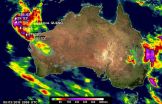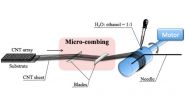(Press-News.org) HOUSTON -- ( May 5, 2015 ) -- The effectiveness of cancer vaccines could be dramatically boosted by first loading the cancer antigens into silicon microparticles, report scientists from Houston Methodist and two other institutions in an upcoming Cell Reports (early online).
Model studies showed that microparticles loaded with an antigen, HER2, not only protected the antigen from premature destruction, but also stimulated the immune system to recognize and relentlessly attack cancer cells overexpressing the HER2 antigen.
"We could completely inhibit tumor growth after just one dose of the cancer vaccine in the animal model," said principal investigator Haifa Shen, M.D., Ph.D. "This is the most amazing result we have ever seen in a tumor treatment study."
The success of the treatment, Shen and his team learned, appears to be the porous silicon microparticles (PSMs) themselves. In vivo and in vitro studies confirmed the microparticles stimulated a strong, sustained innate immune response at local sites of tumor activity and growth -- with or without any antigen loaded.
"We have shown for the first time that a microparticle can serve as a carrier for sustained release and processing of tumor antigens," Shen said. "But just as importantly, we learned the microparticles themselves appear to be enough to stimulate a type I interferon response, and were even transferred from one antigen-presenting cell to another to maintain a long-lasting antigen-releasing effect."
Cancer vaccines are designed to turn a patient's own immune system more strongly against cancer cells, and have been an area of recent and intense interest among oncologists. Since 2010, the FDA has approved vaccines and other immunotherapy drugs for melanoma, prostate cancer, and lung cancer. There are currently dozens of active clinical trials evaluating vaccines for cancer therapy.
Approximately 235,000 new diagnoses of breast cancer were made last year, and over 40,000 patients died from the disease. As yet, there are no FDA-approved vaccines for breast cancer. Such a vaccine might target HER2, a cell surface hormone receptor that is overexpressed in the tumor cells of 15 to 30 percent of breast cancer patients. (Such cells are called HER2+ or HER2 positive.) In this case, HER2 is both a naturally occurring hormone receptor and an antigen target for therapy.
A vaccine against HER2 would train the immune system's more destructive agents to recognize the cancer cells overproducing HER2 and destroy them, leaving healthy cells more or less alone. But so far, vaccines against HER2 have seen only moderate success.
"Vaccines targeting the HER2 oncoprotein have been tried," Shen said. "But these vaccines have mostly not been very potent because of inefficient vaccine delivery, a poor immune response at the site of the tumor, and other factors. We have shown that the PSM-mediated vaccine is not only potent enough to trigger tumor cell killing, but also modifies the tumor microenvironment in a way that favors tumor treatment."
An important aspect of PSM function is stimulating the body's own immune system to fight cancer, Shen said.
"PSMs persistently challenge the antigen-presenting cells to activate the T cells," he said. "And the PSMs modify the tumor microenvironment so that the cytotoxic T cells maintain their activity."
Shen said the use of PSMs could work for any variety of cancer antigens and cancers, and that the PSMs could be loaded with multiple antigens for a single vaccine target, or multiple antigens for several targets, possibly enhancing the approach's effectiveness further.
"Besides developing a highly potent breast cancer vaccine, we have also demonstrated that PSMs are versatile," Shen said. "This is a technology platform that can be applied by other scientists to develop vaccines for other types of cancers, ultimately helping, we hope, more types of cancer patients."
Before human clinical trials can begin, Shen said the researchers must evaluate the toxicity of antigen-loaded PSMs.
INFORMATION:
Also contributing to the Cell Reports paper were Xiaojun Xia (first author), Junhua Mai, Rong Xu, Jorge Enrique Tovar Perez, Maria L. Guevara, Qi Shen, Chaofeng Mu, Xuewu Liu, HMRI President & CEO Mauro Ferrari, Zhiqiang Zhang, Xian Chang Li, and Rong-fu Wang (Houston Methodist Research Institute), Hui-Ying Tung and David B. Corry (Baylor College of Medicine), and Scott E. Evans (University of Texas MD Anderson Cancer Center). Work was supported by grants from the U.S. Department of Defense (W81XWH-09-1-0212 and W81XWH-12-1-0414), the National Institutes of Health (U54CA143837 and U54CA151668), and the Cancer Prevention Research Institute of Texas (RP121071).
To speak with Dr. Haifa Shen, please contact David Bricker, Houston Methodist, at 832-667-5811 or dmbricker@houstonmethodist.org.
"Porous Silicon Microparticle Potentiates Anti-Tumor Immunity by Enhancing Cross- Presentation and Inducing Type I Interferon Response," by Xia et al, Cell Reports (early online, open access funded by authors) http://dx.doi.org/10.1016/j.celrep.2015.04.009
An intervention to connect low-income uninsured and Medicaid patients to a reliable source of primary health care shows promise for reducing avoidable use of hospital emergency departments in Maryland. A University of Maryland School of Public Health study evaluating the results of the intervention was published this week in the May issue of the journal Health Affairs.
For twenty years, use of hospital emergency departments has been on the rise in the United States, particularly among low-income patients who face barriers to accessing health care outside of hospitals ...
The rainfall accumulation analysis above was computed from data generated by the Integrated Multi-satellite Retrievals for GPM (IMERG) during the period from April 28 to May 3, 2015. During this period IMERG algorithms continuously merged and interpolated satellite passive microwave precipitation estimates and microwave-calibrated infrared (IR) satellite estimates over the entire globe.
Rainfall from cyclone Quang fell over the west coast and a non-tropical system pounded the east coast of Australia simultaneously during the past weekend. Cyclone Quang formed in the South ...
A pilot study has found that participating in a nine-week training program including elicitation of the relaxation response had a significant impact on clinical symptoms of the gastrointestinal disorders irritable bowel syndrome and inflammatory bowel disease and on the expression of genes related to inflammation and the body's response to stress. The report from investigators at the Benson-Henry Institute at Massachusetts General Hospital (MGH) and at Beth Israel Deaconess Medical Center (BIDMC), published in the open-access journal PLOS ONE, is the first to study the ...
Out loud, someone says, "The man is catching a fish." The same person then takes pen to paper and writes, "The men is catches a fish."
Although the human ability to write evolved from our ability to speak, writing and talking are now such independent systems in the brain that someone who can't write a grammatically correct sentence may be able say it aloud flawlessly, discovered a team led by Johns Hopkins University cognitive scientist Brenda Rapp.
In a paper published this week in the journal Psychological Science, Rapp's team found it's possible to damage the speaking ...
Environmental factors similar to those affecting the present day Great Barrier Reef have been linked to a major slowdown in its growth eight thousand years ago, research led by the University of Sydney, Australia shows.
"Poor water quality, increased sediments and nutrients - conditions increasingly being faced by the modern day reef - caused a delay in the Reef's growth of between seven hundred and two thousand years duration," said Belinda Dechnik, from the University of Sydney's School of Geosciences and lead author of an article published in Marine Geology in May. ...
Why does a species not adapt to an ever-wider range of conditions, gradually expanding its geographical range? In their paper published on May 5 in PNAS (Proceedings of the National Academy of Sciences), Jitka Polechova and Nick Barton at the Institute of Science and Technology Austria (IST Austria) seek to answer this question, which lies at the interface between ecology and evolution. The theory presented by Polechova and Barton suggests that any natural population is liable to form sharp margins.
J.B.S. Haldane, one of the founders of population genetics, studied ...
In cooperation with a Swiss research team, geographers of Ludwig-Maximilians-Universitaet (LMU) in Munich have developed a novel measuring system relying on two different physical methods that promises to enhance forecasting of avalanches and spring floods. The method combines GPS and radar to measure snow properties also on the slopes.
Accurate forecasting of avalanches, and the risk of flooding in Alpine catchment areas during the spring thaw, primarily requires time-resolved data on snow volumes and the levels of liquid water in the snow cover. A research group led ...
Researchers from North Carolina State University and China's Suzhou Institute of Nano-Science and Nano-Biotics have developed an inexpensive technique called "microcombing" to align carbon nanotubes (CNTs), which can be used to create large, pure CNT films that are stronger than any previous such films. The technique also improves the electrical conductivity that makes these films attractive for use in electronic and aerospace applications.
"It's a simple process and can create a lightweight CNT film, or 'bucky paper,' that is a meter wide and twice as strong as previous ...
Alzheimer's disease (AD) is a neurodegenerative condition that strikes at the heart of what makes us human: the ability to think, to feel, to remember and to communicate with those around us. The tragedy is compounded by the fact that there is currently no cure, no treatment, and no diagnostic method capable of identifying Alzheimer's at its early stages.
A ground-breaking study has now, for the first time anywhere, characterized early-stage changes that occur inside individual, Alzheimer's-affected cells in the intact brain. Remarkably, the study indicates that even ...
How many websites have you clicked on recently that haven't converted their format to mobile, frustrating your efforts to get the information you need in an effective and timely way?
Now researchers from Northwestern University have unearthed some provocative facts on how consumers utilize their mobile devices to buy groceries. With the global market for smartphones predicted to reach two billion by 2016, their findings should convince retailers planning marketing strategies and advertising campaigns that they need to pay attention to mobile.
In "On the Go: How Mobile ...


